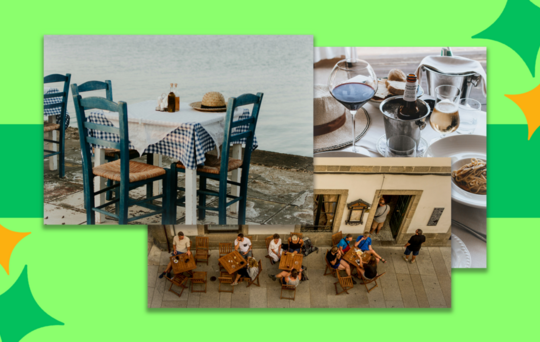Our in-house experts share their tips for optimising your restaurant listing on TheFork

Once you’re up and running with TheFork's online booking platform, you’ll have access to the world’s largest community of over 20 million loyal diners, and over 490 million travellers using TripAdvisor to discover brilliant restaurants like yours.
But while we can introduce your restaurant to more customers, it’s up to you to make diners choose to book your restaurant. So, how do you create the perfect, optimised profile for your restaurant on TheFork to increase bookings, drive revenue, and build a devoted fanbase?
We spoke to some of our Account Managers, who work with restaurateurs to improve their restaurant’s success on TheFork and TripAdvisor’s platform, to get their top tips for optimising your restaurant for more bookings.
1. Make sure your branding is strong and consistent
Whatever it is your website, social media, or interior design conveys about your restaurant, be sure to carry this over to your page on TheFork and show off what it is that makes you unique.
An inconsistent brand identity can be jarring — or worse, off-putting — to customers, so keep your messaging and imagery as close as possible to how they are across your other marketing channels.
Account Manager Amelia Disney suggests one way you can make your profile even more true to your brand: “In the About section, you can add a note from the chef, which is a nice way to inject an extra bit of personality.”
2. Keep your information relevant and accurate
Your page on TheFork has plenty of places for you to share information that will help your customers decide to dine with you, so you need to keep these details updated and accurate to set the right expectations and encourage more bookings. Vague opening times or unclear menu options may put customers off.
“If you’ve got a special event on or you’re changing your timings slightly, ensure that you’re conveying the right information,” Amelia says. “We want to make sure we’re promoting your restaurant correctly.”
Your menu is particularly crucial to keep up-to-date, and we’d recommend including at least 20 items in the A La Carte menu on TheFork to give diners a well-rounded view of what you have to offer.
Try TheFork now
3. Up-to-date and engaging imagery is essential
Everyone knows that people eat with their eyes, so the imagery on your page must be high-quality, authentic, and appealing. It’s also the first thing potential diners will see when they’re browsing for a restaurant to dine at, so your first image needs to be eye-catching enough to get them onto your page.
Once you’ve hooked your potential diner enough to visit your page, you’ll need a varied collection of up-to-date images that showcase exactly what kind of dining experience you offer.
“You should be updating your pictures every one to two months to keep things fresh,” Peter James, Senior Key Account Manager advises. “Your content needs to be just as up-to-date as it is on social media.”
Many diners will look at your pictures to decide what they’d like to order from your menu, so if you don’t have any images of the dishes you’re currently serving, you could be missing out on additional bookings.
Dining out isn’t just about the food, however, it’s about the full experience, so make sure your imagery also accurately captures the atmosphere and unique interior design of your restaurant.
“70% of diners like to see imagery of the venue and the seating areas so they understand the restaurant’s atmosphere before they dine,” Amelia explains. “They’re not just coming for the food.”
4. Respond to reviews
You don’t need us to tell you about how important it is to encourage your customers to leave a review for your restaurant. But what do you do with those reviews once they land on your profile?
Try and respond to as many of your reviews as possible to show how much you care about your customers and value their feedback, whether it’s positive or constructive.
Because, while every restaurant strives to deliver an exceptional experience to customers each time they dine, the reality is that things won’t always be completely perfect. If you do receive any negative reviews, use them as a chance to showcase your commitment to going above and beyond for your customers.
Peter says: “If someone's had a bad experience and you can see the restaurant has replied to it, it creates authenticity instead of making it seem like it’s been brushed under the carpet.”
Responding to reviews is also another powerful opportunity to showcase your restaurant’s tone of voice and messaging.
Amelia suggests: “Put your own voice in there, and respond with clarity and respect”.
5. Take advantage of tags
Consider what your target demographic of customers will be searching for from a restaurant — whether that’s a certain type of atmosphere or a specific dish — on TheFork, and make sure they’re aware that you offer it. You can do this by adding back-end bookable ‘tags’ to your restaurant listing.
While these tags are an effective way of getting your restaurant in front of the right customers, you need to keep on top of regularly updating them.
“They should change seasonally,” Peter advises. “In winter, people might look for a place with a fire. In summer, they’re looking for a place with a terrace, so you have to think proactively about highlighting that.”
Without giving customers a detailed view of the dining experience on offer, you could go unnoticed by diners who are looking for a restaurant just like yours.
You can also use these tags to highlight upcoming seasonal events you’ll be celebrating, so diners can plan early for special occasions, like Mother’s Day or Easter Sunday. You could even promote occasions you’re not celebrating, such as an ‘Anti-Valentine’s Day’ event.
By following these tips, you’ll create an enticing, fully optimised profile on TheFork that will get more diners through your doors while building stronger relationships with your regular customers.
Discover more tips and tricks for attracting new customers on TheFork Manager blog
















